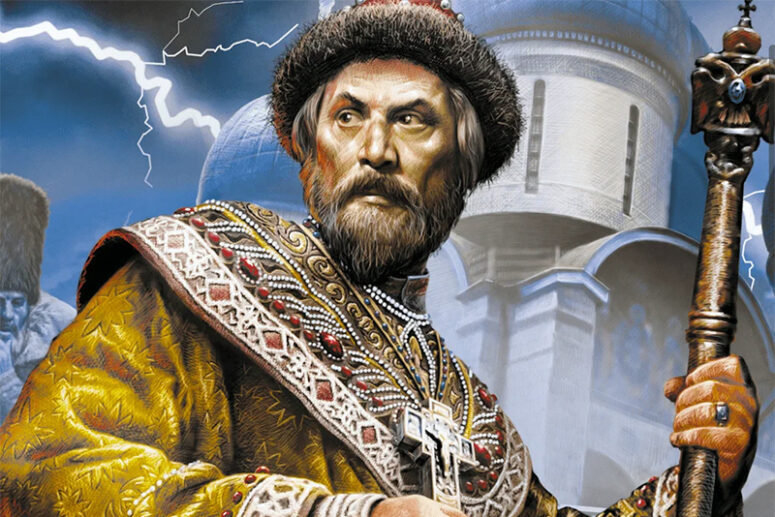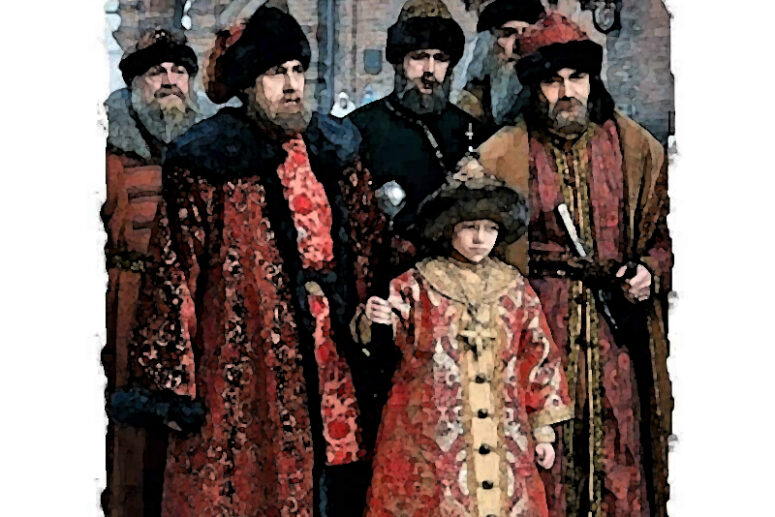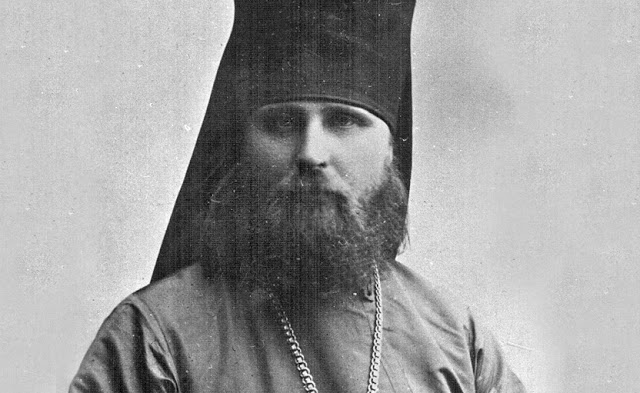
The contradictory personality of Ivan the Terrible seems to combine the inner portraits of two antipodes. His pathological cruelty and mass atrocities are a historical fact. The tsar brutally executed people on the slightest suspicion of treason, invented and participated in tortures and led a dissipated life, for which he was even excommunicated from the Eucharist. He and his henchmen sowed terror among the nobility and the common people. The sobriquet “Terrible” appeared after the Tsar’s death, while during his lifetime he was commonly called “the Torturer”. At the same time, Ivan Vasilievich was a connoisseur of the Scriptures who was constantly present at divine services, spent hours in prayer and hardly missed an opportunity to enter into a theological dispute with representatives of non-Orthodox denominations. How did these qualities appear, develop and coexist in the character of the Tsar of All Russia?
Ivan IV was not alone — bloody tyrants were common in Europe as well. Queen Elizabeth I of England hated vagrants and passed a law according to which they were hanged without trial. St. Bartholomew’s Day massacre, instigated by Queen Catherine de’ Medici, alone claimed the lives of at least 3 thousand people in one night. In fifteenth-century Spain and Portugal, with the blessing of the authorities, heretics (most often Jews) began to be publicly burned at the stake, which continued until the beginning of the 19th century. This list of atrocities goes on.
It is also noteworthy that the common translation of the epithet Grozny as “the Terrible” is not exact. “Grozny” would be better translated as formidable or fearsome. Unlike “terrible”, this quality is not necessarily negative. A ruler should be grozny for his enemies; a father is grozny towards a disobedient son. The voice of God in the synodal translation of the Bible is also grozny (Ps. 18:15).
Childhood Trauma
Childhood trauma can drastically affect a person’s later life. Studies show that a difficult childhood leads to problems with socialisation [ 1 ] and mental health, causing depression and anxiety, [ 1 2 ], undermining a person’s ability to lead a family life [ 1 ] etc. Unfortunately, the childhood of Ivan IV was nothing but trauma.
The boy became an orphan and a ruler on the same day at the age of three, when his father Vasily III died in 1533. Before Vasily’s death, he appointed representatives of the highest aristocratic class (the boyars) to take care of the Grand Duke until he came of age, that is, up to 15 years.
Five years later, the mother of eight-year-old Ivan died. The fact that the child was orphaned so early affected his psychological development.
Both of Ivan’s parents died under strange circumstances. His Father was diagnosed with some kind of subcutaneous abscess. The doctor examining him declared that it was fatal and provided no further assistance. The death of Ivan’s mother was also sudden. The reasons are not known for certain, but the most common version says that she was poisoned by the boyars.
Apparently, the boyars taking care of the young Tsar, did not cope with their task, which largely shaped Ivan’s hatred of them. Below are several extracts from his personal letters: “I remember Prince Ivan Vasilievich Chouiski sitting on a bench while we used to play children’s games, leaning his elbow on our father’s bed and putting his foot on a chair. He did not even bother looking at us—neither as a parent, nor as a guardian, let alone like a slave to the masters. Who can endure such pride?”, “We, along with my only-begotten brother, George, who has died in the Lord, began our lives being brought up as strangers and the poorest of paupers. We suffered hardships both in clothing and in food. <…> How many times I was not even allowed to eat on time. <…> How can one measure the countless sufferings that I endured in my youth?”

By the way, it is Prince Ivan Vasilievich Chouiski who is commonly believed to have poisoned the mother of Ivan IV. At a mature age, Ivan the Terrible personally accused him of embezzlement and removed him from power. The death of the boyar was also sudden and dubious. One way or another, boyars seem to have become in the eyes of Ivan the Terrible the bearers of evil and betrayal.
Living a life full of trials, Ivan IV found solace in prayer. From his childhood, Ivan could pray for hours. In 1541, when the future tsar was only 11 years old, the Crimean Khan invaded Russian lands. During the key battle, the young Grand Duke stayed in the Assumption Cathedral in Moscow where he prayed long and hard for the victory of his army. When the battle was over, the governor came to him and said that the victory had been won by his prayers. Perhaps, this was a turning point when Ivan the Terrible began to sacralize his own figure.
In subsequent years, this sacralization reached the absolute, when the Tsar justified any of his actions by his chosenness. His personality seems to have split in two: he himself considered his actions sinful as a man, but righteous as a Tsar. Seeing his main goal as the Tsar in the prosperity of his state, Ivan IV considered any means suitable if they helped to achieve this goal.
As a child, Ivan was impatient and even violent. By the age of 12, his cruelty manifested itself as he threw cats and dogs from the Kremlin walls. By 15, he would shed the blood of ordinary peasants, saddling horses with his friends and going on robberies, which did not interfere with his outward piety.
Faith and violence
The religiosity of Ivan IV increased with age, and so did his cruelty. This is evidenced by the Synodicon of the Disgraced—a list of names for commemoration compiled at the end of the Tsar’s life on his orders. The list contained the names of those who suffered during his reign. It was forwarded to monasteries and temples churches along with generous donations. Having personally compiled the Synodicon, Ivan the Terrible announced that he was granting his forgiveness to all the executed. Many innocent people were killed due to the cruelty of the Tsar. Never repenting publicly, he did however take care of their church commemoration.
The synodic itself has been preserved only partially. The most complete of the surviving copies contains 3300 names. The listed victims suffered during the periods between 1564-65, 1567-70, and 1571-75. At the same time, Ivan IV ruled from 1533 to 1584 (he was crowned in 1547). According to various estimates, the number of victims during his reign is about 30,000 people.
It is noteworthy that the Tsar’s outbursts of anger and his ascetic zeal were equally sudden and chaotic. This made them similar to attacks of some kind of illness. Anger caused Ivan the Terrible to shake and tremble, tearing his hair with foam at the mouth. He could set upon anyone with blows or even bites. During such attacks, the Tsar could give orders to execute his closest and most faithful associates. Sometimes these sudden attacks occurred at night, as Ivan IV experienced problems with sleep.

Just as suddenly, he began to repent, stopping all his activities and travelling to monasteries, where he fervently prayed. He made earth-low bows in a way that left bumps and bloody marks on his forehead. Although the tsar never retreated from his cruelty, he repented during church services, shedding tears about his own atrocities. However, immediately after the end of the service, he would often return to tortures, which he carried out with the same zeal.
The Tsar’s actions were in direct conflict with faith. It is paradoxical that at the end of the 20th century a movement for the canonization of Ivan the Terrible began. The supporters of this movement considered all information about the cruelty of the Tsar to be false. Of course, if we consider them as such, then Ivan the Terrible really is an example of holiness. Besides being a man of prayer, he convened and participated in councils. More than 40 stone churches were erected during his reign, with more than 60 monasteries founded. According to various sources, 39 to 52 Russian saints were glorified; ascetic and practical works were published, such as the Great Menaion Reader, or the Domostroy Household Book. The Tsar composed hymnographic works, and received the great schema at the end of his life.
However, there is no valid reason to neglect the numerous sources confirming the atrocities of Ivan Grozny. The idea of his canonization was condemned by church historians Archim. Macarius (Veretennikov), archpriest Vladislav Tsypin, Alexander Dvorkin, archdeacon. Andrey Kuraev, Abbot. Damaskin (Orlovsky), as well as the Church hierarchy — Patriarch Alexy II and Metropolitan Vladimir (Sabodan).
Psychological and Religious Portrait
The early loss of parents, servility mixed with indifference towards the child on the throne, the naturally violent temper and permissiveness formed a fertile ground for the development of mental pathologies.
Modern psychiatrists assume different diagnoses. Candidate of Medical Sciences M.I. Buyanov believed that the Tsar suffered from epileptoid psychopathy. Dr. Habil. A.E. Lichko speaks about paranoid personality disorder.
The most common symptoms of epileptic psychosis include anxious and angry mood and suspicion, a growing feeling of anxiety, anger, a sharp change in mood, lack of control over one’s emotions and actions, sleep disturbance, hallucinations, delusions, overvalued ideas. All these symptoms can be seen in the behavior and character of Ivan the Terrible: sharp mood swings from deep repentance to bloody rage, psychotic seizures, visions, conviction in one’s own absolute exclusivity and constant search for internal and external enemies.
Psychiatrists also notice Ivan Vasilievich’s morbid religiosity, manifested as chaotically as the exacerbations of psychosis. Formally observing external piety and even praying earnestly, he continued to commit anti-Christian deeds, not seeing any contradiction in this. He believed that being the anointed of God gave him infallibility in all his deeds, even the most monstrous ones. Clearly, such a view of the royal anointing in no way corresponds to Orthodox dogma, but is a criminal self-justification.
The only thing that one can say with confidence about the religiosity of Ivan the Terrible is that he meticulously observed its outer, formal side. However, this did not lead to any changes in his personality, similar to those that occurred in Equal-to-the-Apostles Prince Vladimir. He donated large sums of money to churches and monasteries, but these sacrifices were not like the poor widow’s mite (Lk. 21:1-4), because the Tsar had many riches. “I desire steadfast love and not sacrifice, the knowledge of God rather than burnt offerings” (Hosea 6:6). God Himself designates what is worthier for Him. Ivan the Terrible, being a connoisseur of Scripture, must have had a perfect understanding of this, but he never showed mercy.





Thank you so much. I have recently read an opinion espousing that Ivan the Terrible was misunderstood, and talked about the good he did such as the building of many churches. This gives me a balanced view. He was clearly damaged as a child and this haunted his life. The fact he kept track of 3000 people that he had wronged does show that his cruelty bothered him and when he committed these acts he regretted them. I feel for him, what he went through as a child would damage anyone, but the cruelty he imposed on others, is unfathomable. Only Christ knows what afflicted him. May God have mercy on his soul.
Thank you too. The whole story is very sad. The more details, the worse it gets. As was said in the article, this list with the names of the victims has not survived in its entirety. It is not known how many names were there originally.
There is one theory that he may have suffered from mercury poisoning, which could explain his erratic “mercurial” behavior. Mercury was often used in hat making and may have contaminated crowns or hats worn by the Tzar.
An autopsy of Ivan the Terrible’s body revealed elevated levels of mercury. Mercury was part of many medicines. This includes drugs for syphilis, which Ivan the Terrible supposedly had. The theory of poisoning is not confirmed, but also not denied.
I am surprised that for an otherwise very erudite and considered account of Ivan IV, there is no mention of his Oprichniki, basically Russia’s very first organised, government sponsored “Secret Police”. Many times their raids were led by Ivan himself. Their very symbolic monastic clothing – black robes and hoods, riding black horses adorned with a wolf’s or dog’s head (to sniff out treason/irreligious) and a broom (to symbolise sweeping it away). Like their leader Ivan, they lived an outwardly ascetic lifestyle, similar to the monks they emulated, but punctuated by acts of cruelty and debauchery.
Perhaps they deserve their own, dedicated article as a follow-up to this one?
The story of the oprichniks and the establishment of the oprichnik “monastery” was originally present in the article. I write articles in Russian, and then they are sent to translators. For this reason I need to stick to a certain length of text. The original article was too big to translate, so it had to be shortened.
Yes, the oprichniks deserve a separate article. But I am not sure it will be possible anytime soon.
This does not strike me as a particularly pious life. Rather, it strikes me as someone whose apparently pious actions are created more from a fear of hell and the Judgment rather than a true repentance. How many times have I heard from priests that true repentance produces a true change of life? Many!
I, a sinner, cannot and should not judge his life. Only the merciful God may do so, yet I am perplexed at how one might receive the life-giving Sacrament of the Eucharist and not be changed. How does this happen?
The best thing I can do for Ivan Grozny is to add his name to the list of deceased for whom I pray, realizing that I am equally worthy of condemnation for the many sins I committed before my conversion to the true faith.
Lord have mercy!
Very true! Lord have mercy!
Orthodoxy is one that sacramentalizes the entire man in the Creation. The recreation of new Adam by Christ in the human transforms; and is a cosmological mystery. The compartmentalization of man is something so common in the West. It is something that isolates us from cooperation with our salvation. There was the cruel Ivan leader and the pious Ivan pleading to God for the atrocities diametrically and is a paradox of faith. It seems there was a war going on in his soul. I do think that there was something off that affected the personality of Ivan, but trauma can be used by the enemy of our souls to damage the creation of God. I do think his position and authority had something to do this idea of self aggrandizement. King Saul appeared to be cut from the same cloth in Holy Scripture. It was odd that there was no patriarch or Bishop that challenged his immoral actions. It seems the coldness of the ecclesiastical authorities lacked the courage to confront because they feared he would execute them or they cooperated because he expanded the monasteries and sent commemorations. Ivan appeared to have deep remorse for his actions but showed no repentance. We should learn from him.
Quote: ‘It was odd that there was no patriarch or Bishop that challenged his immoral actions”.
Thankfully, you are wrong.
Metropolitan Philip of Moscow (there were no patriarchs in Rus at that time) opposed Ivan the Terrible. For this he was killed.
https://orthodoxwiki.org/Philip_II_of_Moscow
And he was not the only one. As far as I know, only one man, st. Nicholas, was not executed after denouncing the tsar: https://orthodoxwiki.org/Nicholas_(Salos)_of_Pskov
Sadly, abuse is abuse. I had a sister that took pleasure in creating pain. She destroyed our family.
Her behavior prepared me for the evil that exists in the world. I am blessed with being a poet and Chaplain. There will always be evil and those who take that path. I am thankful I have responded with love and compassion.
Well, I think the problem, historically, is that with rulers, there are a lot of tales and chronicles, but everyone sort of has a dog in the fight. Look at Procopius’ secret history of Emperor Saint Justinian, for example. We do not believe the things recounted there, even though it was written very closely to the time of its subject. With Tsar Ivan IV, much of the bad stuff comes from a traitor– Kurbsky.
The Synodicon of the Disgraced is not an acknowledgment of his guilt, but a recognition that those whom he had executed or otherwise caused to die (I think the actual cause of Met. Philip’s death is disputed) needed God’s mercy.
The fact that this man composed Church canons, convened Church councils, submitted to Church penances (as when the bishops excommunicated him for his wives beyond the third), built Churches, made war to subjugate lands to the Gospel, and did so many other things merits a serious historical review about what misdeeds we can actually verify that he did.
His ideas about the rights of the king certainly sound medieval and unenlightened to modern ears, but it was commonly believed that the Christian Ruler was the anointed of God to bear the sword, and had the power of life and death over all his subjects, as God’s viceroy. Such was the piety toward Christian emperors that, although many Byzantine Emperors were heretics, none of them were ever anathematized by the Church (except, I think, perhaps, for Julian the Apostate).